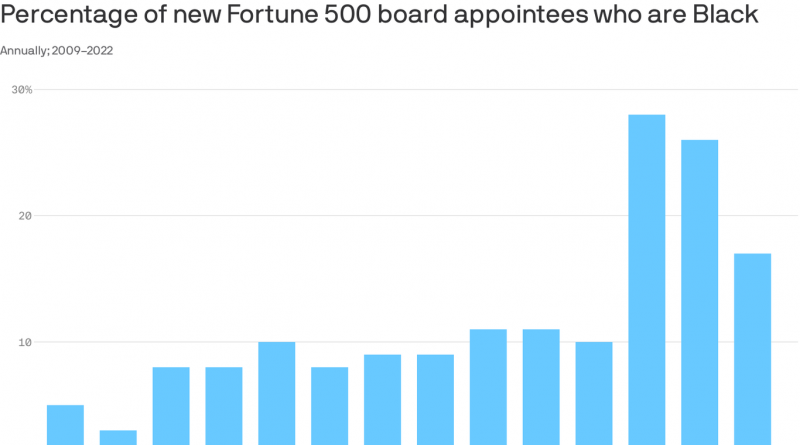Share of Black and women appointees to Fortune 500 boards declined last year
The boardroom diversity push lost some steam last year. The share of new Fortune 500 board seats going to underrepresented groups declined, according to a report out this morning from executive search and leadership consulting firm Heidrick & Struggles.
The big picture: The murder of George Floyd and subsequent racial justice protests galvanized companies to ramp up diversity efforts in 2020 and 2021, with a significant jump in Black appointees to corporate boards.
- But the number of Black appointees shrank in 2022 — though it's still at ahigher level than 2019.
- Meanwhile, diversity-focused roles at companies are disappearing through attrition, according to a report from NBC.
By the numbers: 34% of board appointments last year went to someone belonging to a racial or ethnic minority — down from 41% in 2021.
- The decline was largely driven by a big drop in the percentage of Black appointees — to 17% from 26% in 2021. (In 2019, the share was just 10%.)
- The share of board seats going to women declined to 40% in 2022, compared to 45% in 2021, which had been a record high.
- About two-thirds of women appointees were white; 21% Black; 7% Asian or Asian American and 4% Hispanic.
Zoom out: The economic and political uncertainties of 2022 pushed some companies to return to their comfort zone, and that meant appointing more board members with CEO or CFO experience. That population tends to be "less diverse," said Lyndon Taylor, a partner at Heidrick who worked on the report.
- Organizations turned to "individuals who they perceive to add stability," said Taylor.
- Whereas in the past couple years companies were reacting to the social climate, now they're reacting to something new. But the ideal balance would be to think more strategically — and including diverse perspectives on boards remains crucial for the long-term, he says.
Worth noting: The percentage of new board seats going to Asian and Asian-American (9%) or Latino (7%) directors has remained relatively flat for the past four years.
- “The fact that the Hispanic and Latino community represents 18% of the US population but hasn’t seen a significant increase in representation in the 14 years since we started tracking the data shows that far more work needs to be done on equitable representation in this area,” write the authors of the report.
The big question: Is the 2022 decline a downward trend — or a blip in a longer-term upward trend, similar to what's happened with women's representation on boards.
- In 2017, as the MeToo movement swept corporate America, the share of women appointed to boards increased meaningfully, and since then has fluctuated at a higher level.
Go deeper: Despite growth, Latinos are missing from boardrooms
Source: Read Full Article



